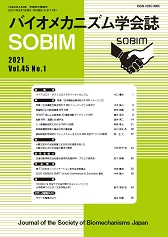All issues

Volume 45, Issue 2
Displaying 1-8 of 8 articles from this issue
- |<
- <
- 1
- >
- >|
Reviews
-
[in Japanese]2021 Volume 45 Issue 2 Pages 64
Published: 2021
Released on J-STAGE: May 14, 2022
JOURNAL FREE ACCESSDownload PDF (1196K) -
[in Japanese], [in Japanese]2021 Volume 45 Issue 2 Pages 65-70
Published: 2021
Released on J-STAGE: May 14, 2022
JOURNAL FREE ACCESS -
[in Japanese], [in Japanese], [in Japanese], [in Japanese]2021 Volume 45 Issue 2 Pages 71-74
Published: 2021
Released on J-STAGE: May 14, 2022
JOURNAL FREE ACCESS -
[in Japanese]2021 Volume 45 Issue 2 Pages 75-79
Published: 2021
Released on J-STAGE: May 14, 2022
JOURNAL FREE ACCESS -
[in Japanese], [in Japanese], [in Japanese], [in Japanese], [in Japane ...2021 Volume 45 Issue 2 Pages 80-83
Published: 2021
Released on J-STAGE: May 14, 2022
JOURNAL FREE ACCESS
Paper
-
-Walking Patterns Changing from Young to Middle and Walking Patterns Changing from Middle to Elderly-Sakiko SAITO, Yoshiyuki KOBAYASHI2021 Volume 45 Issue 2 Pages 84-93
Published: 2021
Released on J-STAGE: July 03, 2021
JOURNAL FREE ACCESSThis study was aimed to understand the effect of age and sex on kinematic and kinetic features during walking. Gait data of 223 healthy adults aged 20 to 75 were obtained from AIST Gait Database. Principal component analysis was performed on the time-normalized joint angle and moment data of one gait cycle computed from 8 joints of whole body and pelvis-laboratory angle. Two-way (age by sex) analyses of variance were conducted on the principal component scores of principal component vectors, each of which explained more than 1% of the variance. The results showed that the 1st and 5th principal components were affected by sex, while the 3rd, 7th and 19th principal components were affected by age. The results of the post-hoc analyses revealed that 7th principal component represents the characteristic that changes uniformly with age, 3rd principal component represents the characteristic that changes from young to middle, and 19th principal component represents the characteristic that changes from middle to elderly, respectively. Furthermore, the kinematic and kinetic features associated with these principal components were reconstructed, and it was found that the anterior-posterior range of motion of the upper limb decreases and the peak values of the angles and moments of the hip and ankle joints at the 50-60% range of gait cycle decrease from young to middle, the gap between the timing of the upper and lower limb movements increases from middle to elderly.View full abstractDownload PDF (2206K) -
Koichiro SATO, Hiroshi YAMADA, Shuichi UCHIYAMA, Keita OGAWARA2021 Volume 45 Issue 2 Pages 95-101
Published: 2021
Released on J-STAGE: July 03, 2021
JOURNAL FREE ACCESSThe purpose of this study was to examine a person experienced soccer and inexperienced soccer perform ball juggling, to compare the movement of the operating leg and electromyogram (EMG) data according to the skill level, and clarify the characteristics of motor control. EMG was recorded from the knee and ankle joint flexors and extensors, and co-contraction index (CCI) was calculated from the obtained data. The movement period when the Ball touched the foot was divided into the touch and kick phase with the moment when the ball was at the lowest position. The result were followed. The amount of muscle activity was smaller the skilled group than the unskilled group. In the Touch phase of the knee joint, the CCI was higher the skilled group than the unskilled group. However, in the Kick phase of the ankle joint, the CCI was lower skilled group than the unskilled group. We concluded that there were differences in the method of motor controlling ball juggling due to differences in skill level. The skilled group fixes the knee joint and performs ball juggling at the ankle joint. On the other hand, the unskilled group fixes the ankle joint and performs ball juggling at the knee joint.View full abstractDownload PDF (2044K)
Series
-
Shuntaro TOJYO2021 Volume 45 Issue 2 Pages 107-111
Published: 2021
Released on J-STAGE: July 03, 2021
JOURNAL FREE ACCESSDownload PDF (1734K)
- |<
- <
- 1
- >
- >|